brake fluid Lancia Delta 2012 Owner handbook (in English)
[x] Cancel search | Manufacturer: LANCIA, Model Year: 2012, Model line: Delta, Model: Lancia Delta 2012Pages: 295, PDF Size: 8.29 MB
Page 13 of 295
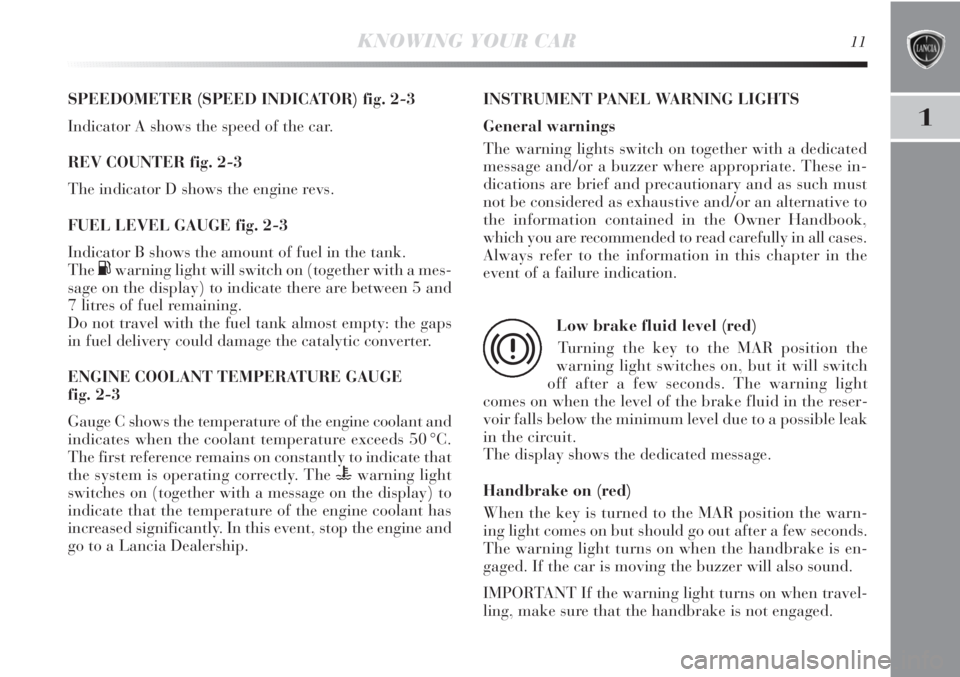
1
KNOWING YOUR CAR11
SPEEDOMETER (SPEED INDICATOR) fig. 2-3
Indicator A shows the speed of the car.
REV COUNTER fig. 2-3
The indicator D shows the engine revs.
FUEL LEVEL GAUGE fig. 2-3
Indicator B shows the amount of fuel in the tank.
The
Kwarning light will switch on (together with a mes-
sage on the display) to indicate there are between 5 and
7 litres of fuel remaining.
Do not travel with the fuel tank almost empty: the gaps
in fuel delivery could damage the catalytic converter.
ENGINE COOLANT TEMPERATURE GAUGE
fig. 2-3
Gauge C shows the temperature of the engine coolant and
indicates when the coolant temperature exceeds 50 °C.
The first reference remains on constantly to indicate that
the system is operating correctly. The
uwarning light
switches on (together with a message on the display) to
indicate that the temperature of the engine coolant has
increased significantly. In this event, stop the engine and
go to a Lancia Dealership.INSTRUMENT PANEL WARNING LIGHTS
General warnings
The warning lights switch on together with a dedicated
message and/or a buzzer where appropriate. These in-
dications are brief and precautionary and as such must
not be considered as exhaustive and/or an alternative to
the information contained in the Owner Handbook,
which you are recommended to read carefully in all cases.
Always refer to the information in this chapter in the
event of a failure indication.
Low brake fluid level (red)
Turning the key to the MAR position the
warning light switches on, but it will switch
off after a few seconds. The warning light
comes on when the level of the brake fluid in the reser-
voir falls below the minimum level due to a possible leak
in the circuit.
The display shows the dedicated message.
Handbrake on (red)
When the key is turned to the MAR position the warn-
ing light comes on but should go out after a few seconds.
The warning light turns on when the handbrake is en-
gaged. If the car is moving the buzzer will also sound.
IMPORTANT If the warning light turns on when travel-
ling, make sure that the handbrake is not engaged.
x
Page 196 of 295

194IN AN EMERGENCY
INFLATION PROCEDURE
Put on the protective gloves provided to-
gether with quick tyre repair kit.
❍Engage the handbrake. Unscrew the tyre valve cap,
take out the flexible filler pipe A-fig. 4 and tighten the
ring nut B on the tyre valve;
fig. 4L0E0077m
The cylinder contains ethylene glycol. Con-
tains latex: may cause an allergic reaction.
Harmful if swallowed. Eye irritant. May
cause sensitisation on inhalation or contact. Avoid
contact with eyes, skin and clothes. In the event of
contact, wash immediately with plenty of water. Do
not induce vomiting if swallowed. Rinse your mouth
and drink plenty of water. Call a doctor immedi-
ately. Keep away from children. The product must
not be used by asthmatics. Do not breathe in the
vapours during insertion and suction. Call a doctor
immediately if allergic reactions are noted. Store the
bottle in the specific compartment, away from
sources of heat. The sealant fluid has a limited life.
Replace the bottle containing out of date
sealant fluid. Dispose of the bottle and the
sealant liquid properly. Dispose according
to the national and local regulations in force.
Page 233 of 295
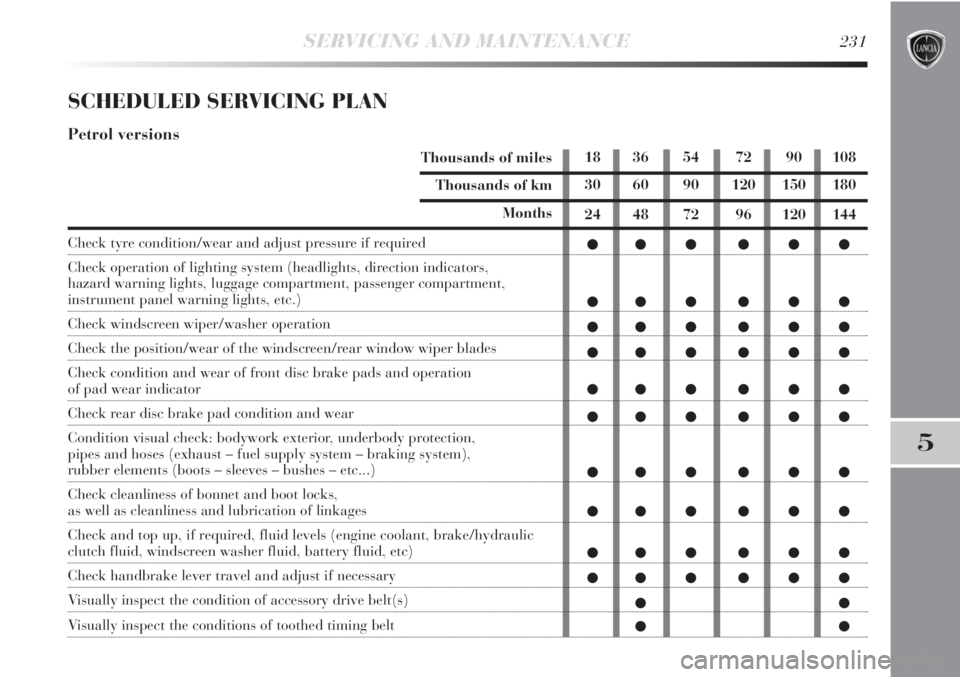
18 36 54 72 90 108
30 60 90 120 150 180
24 48 72 96 120 144
●●● ●●●
●●● ●●●
●●● ●●●
●●● ●●●
●●● ●●●
●●● ●●●
●●● ●●●
●●● ●●●
●●● ●●●
●●● ●●●
●●
●●
SERVICING AND MAINTENANCE231
5
SCHEDULED SERVICING PLAN
Petrol versions
Thousands of miles
Thousands of km
Months
Check tyre condition/wear and adjust pressure if required
Check operation of lighting system (headlights, direction indicators,
hazard warning lights, luggage compartment, passenger compartment,
instrument panel warning lights, etc.)
Check windscreen wiper/washer operation
Check the position/wear of the windscreen/rear window wiper blades
Check condition and wear of front disc brake pads and operation
of pad wear indicator
Check rear disc brake pad condition and wear
Condition visual check: bodywork exterior, underbody protection,
pipes and hoses (exhaust – fuel supply system – braking system),
rubber elements (boots – sleeves – bushes – etc...)
Check cleanliness of bonnet and boot locks,
as well as cleanliness and lubrication of linkages
Check and top up, if required, fluid levels (engine coolant, brake/hydraulic
clutch fluid, windscreen washer fluid, battery fluid, etc)
Check handbrake lever travel and adjust if necessary
Visually inspect the condition of accessory drive belt(s)
Visually inspect the conditions of toothed timing belt
Page 234 of 295
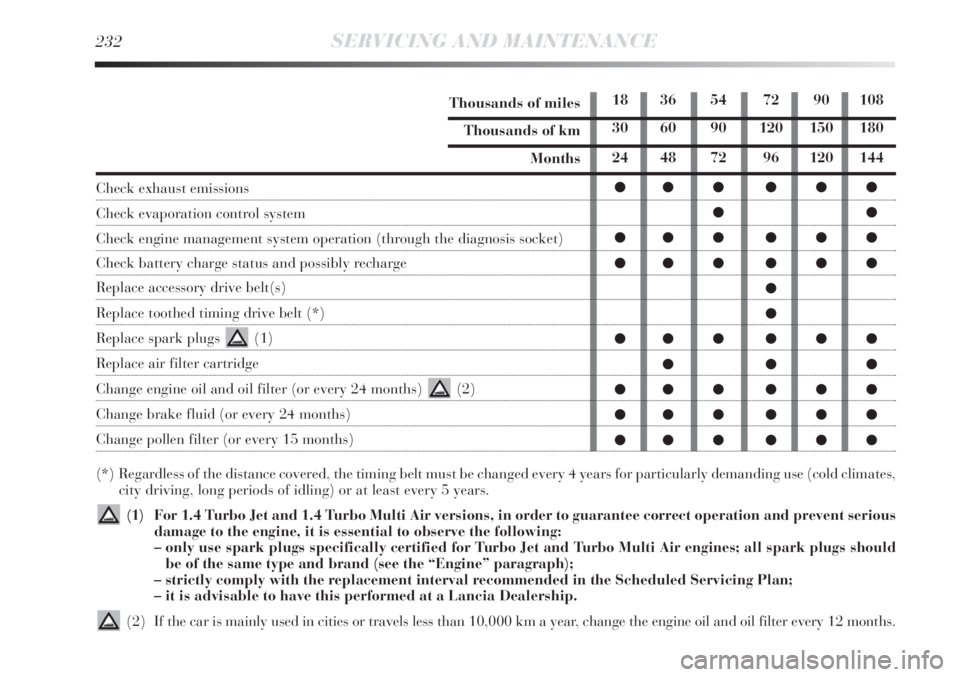
232SERVICING AND MAINTENANCE
Thousands of miles
Thousands of km
Months
Check exhaust emissions
Check evaporation control system
Check engine management system operation (through the diagnosis socket)
Check battery charge status and possibly recharge
Replace accessory drive belt(s)
Replace toothed timing drive belt (*)
Replace spark plugs (1)
Replace air filter cartridge
Change engine oil and oil filter (or every 24 months) (2)
Change brake fluid (or every 24 months)
Change pollen filter (or every 15 months)
(*) Regardless of the distance covered, the timing belt must be changed every 4 years for particularly demanding use (cold climates,
city driving, long periods of idling) or at least every 5 years.
(1) For 1.4 Turbo Jet and 1.4 Turbo Multi Air versions, in order to guarantee correct operation and prevent serious
damage to the engine, it is essential to observe the following:
– only use spark plugs specifically certified for Turbo Jet and Turbo Multi Air engines; all spark plugs should
be of the same type and brand (see the “Engine” paragraph);
– strictly comply with the replacement interval recommended in the Scheduled Servicing Plan;
– it is advisable to have this performed at a Lancia Dealership.
(2) If the car is mainly used in cities or travels less than 10,000 km a year, change the engine oil and oil filter every 12 months.
18 36 54 72 90 108
30 60 90 120 150 180
24 48 72 96 120 144
●●● ●●●
●●
●●● ●●●
●●● ●●●
●
●
●●● ●●●
●●●
●●● ●●●
●●● ●●●
●●● ●●●
Page 235 of 295
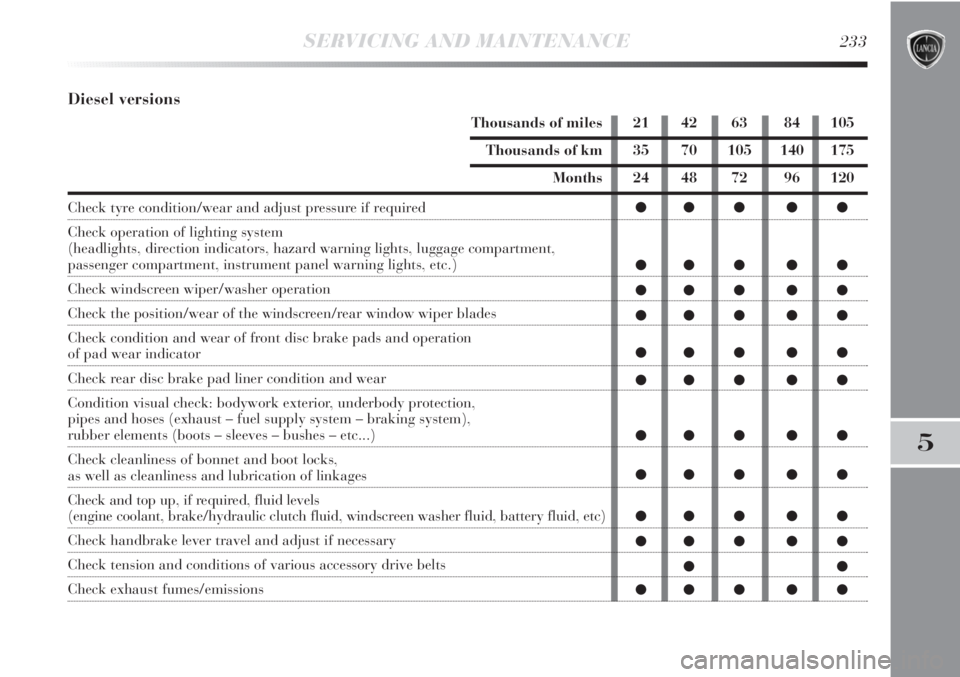
SERVICING AND MAINTENANCE233
5
21 42 63 84 105
35 70 105 140 175
24 48 72 96 120
●● ● ● ●
●● ● ● ●
●● ● ● ●
●● ● ● ●
●● ● ● ●
●● ● ● ●
●● ● ● ●
●● ● ● ●
●● ● ● ●
●● ● ● ●
●●
●● ● ● ●
Diesel versions
Thousands of miles
Thousands of km
Months
Check tyre condition/wear and adjust pressure if required
Check operation of lighting system
(headlights, direction indicators, hazard warning lights, luggage compartment,
passenger compartment, instrument panel warning lights, etc.)
Check windscreen wiper/washer operation
Check the position/wear of the windscreen/rear window wiper blades
Check condition and wear of front disc brake pads and operation
of pad wear indicator
Check rear disc brake pad liner condition and wear
Condition visual check: bodywork exterior, underbody protection,
pipes and hoses (exhaust – fuel supply system – braking system),
rubber elements (boots – sleeves – bushes – etc...)
Check cleanliness of bonnet and boot locks,
as well as cleanliness and lubrication of linkages
Check and top up, if required, fluid levels
(engine coolant, brake/hydraulic clutch fluid, windscreen washer fluid, battery fluid, etc)
Check handbrake lever travel and adjust if necessary
Check tension and conditions of various accessory drive belts
Check exhaust fumes/emissions
Page 236 of 295
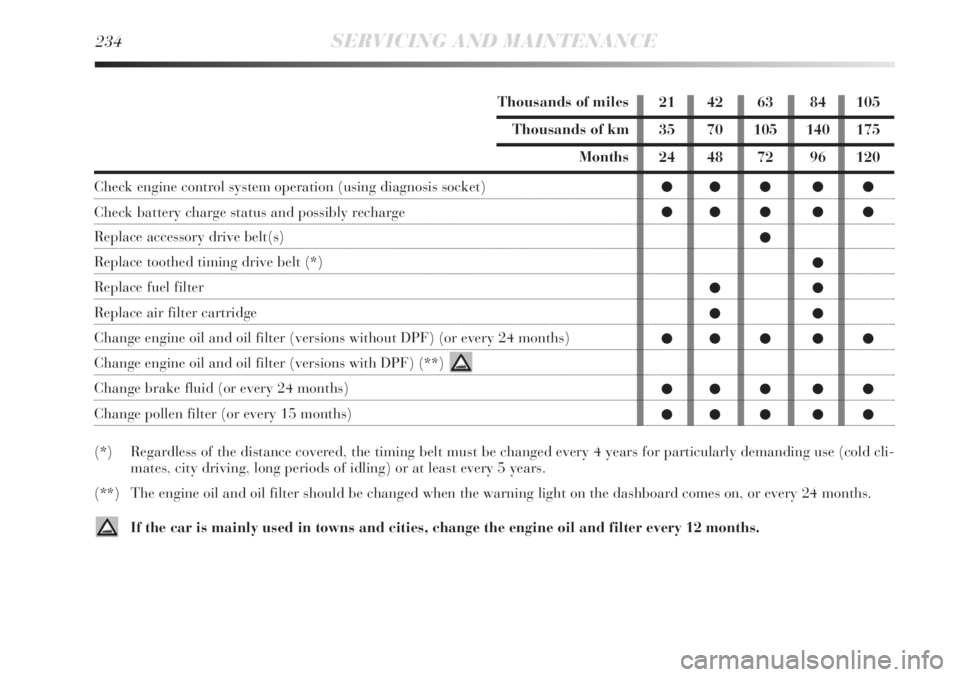
234SERVICING AND MAINTENANCE
Thousands of miles
Thousands of km
Months
Check engine control system operation (using diagnosis socket)
Check battery charge status and possibly recharge
Replace accessory drive belt(s)
Replace toothed timing drive belt (*)
Replace fuel filter
Replace air filter cartridge
Change engine oil and oil filter (versions without DPF) (or every 24 months)
Change engine oil and oil filter (versions with DPF) (**)
Change brake fluid (or every 24 months)
Change pollen filter (or every 15 months)
(*) Regardless of the distance covered, the timing belt must be changed every 4 years for particularly demanding use (cold cli-
mates, city driving, long periods of idling) or at least every 5 years.
(**) The engine oil and oil filter should be changed when the warning light on the dashboard comes on, or every 24 months.
If the car is mainly used in towns and cities, change the engine oil and filter every 12 months.
21 42 63 84 105
35 70 105 140 175
24 48 72 96 120
●● ● ● ●
●● ● ● ●
●
●
●●
●●
●● ● ● ●
●● ● ● ●
●● ● ● ●
Page 237 of 295
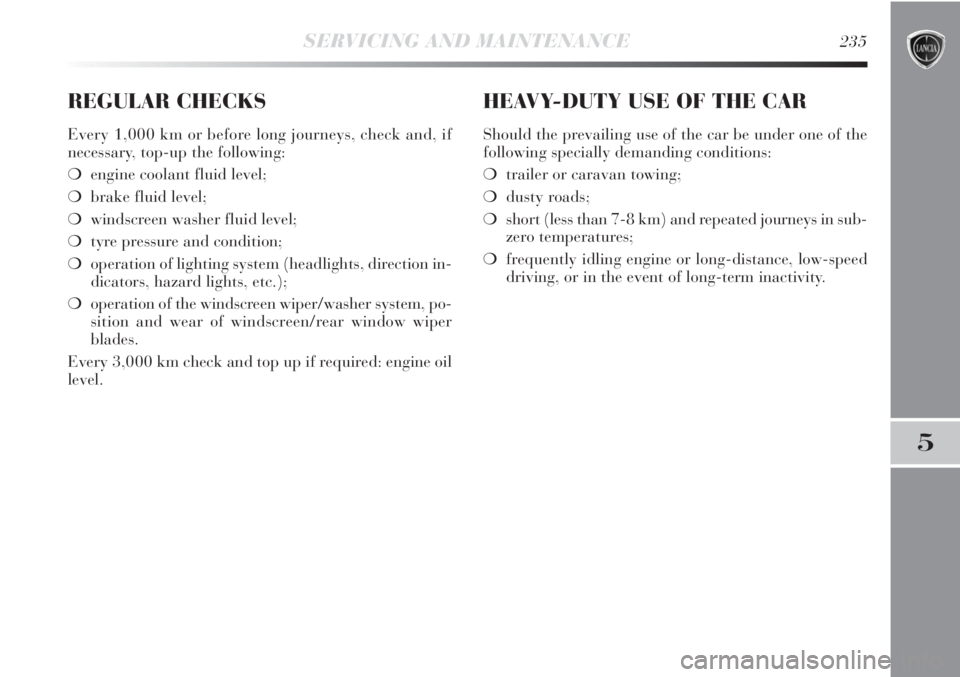
SERVICING AND MAINTENANCE235
5
REGULAR CHECKS
Every 1,000 km or before long journeys, check and, if
necessary, top-up the following:
❍engine coolant fluid level;
❍brake fluid level;
❍windscreen washer fluid level;
❍tyre pressure and condition;
❍operation of lighting system (headlights, direction in-
dicators, hazard lights, etc.);
❍operation of the windscreen wiper/washer system, po-
sition and wear of windscreen/rear window wiper
blades.
Every 3,000 km check and top up if required: engine oil
level.
HEAVY-DUTY USE OF THE CAR
Should the prevailing use of the car be under one of the
following specially demanding conditions:
❍trailer or caravan towing;
❍dusty roads;
❍short (less than 7-8 km) and repeated journeys in sub-
zero temperatures;
❍frequently idling engine or long-distance, low-speed
driving, or in the event of long-term inactivity.
Page 238 of 295
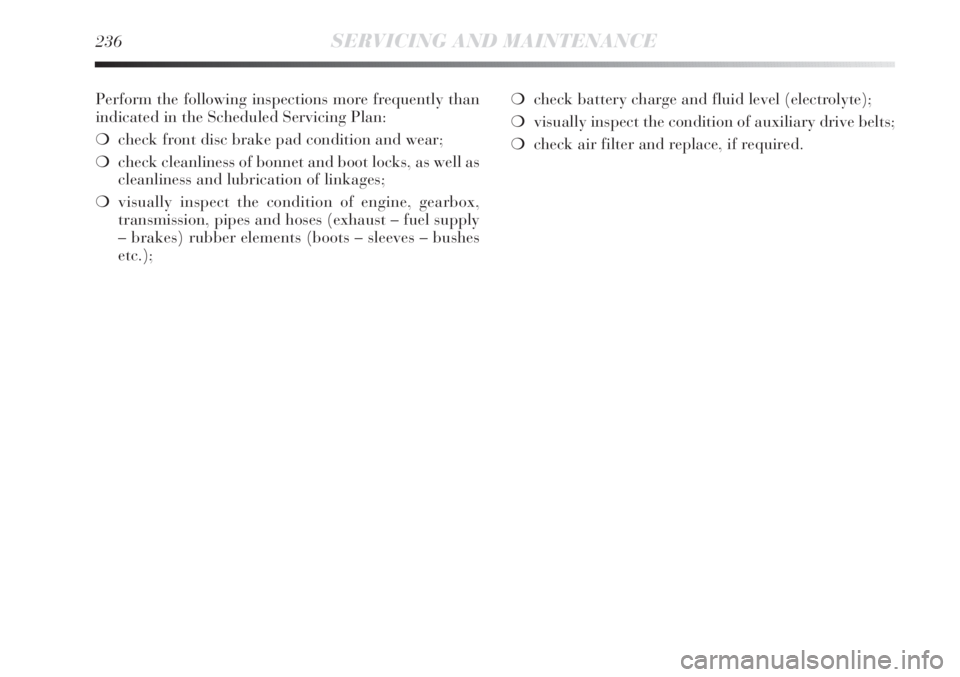
236SERVICING AND MAINTENANCE
Perform the following inspections more frequently than
indicated in the Scheduled Servicing Plan:
❍check front disc brake pad condition and wear;
❍check cleanliness of bonnet and boot locks, as well as
cleanliness and lubrication of linkages;
❍visually inspect the condition of engine, gearbox,
transmission, pipes and hoses (exhaust – fuel supply
– brakes) rubber elements (boots – sleeves – bushes
etc.);❍check battery charge and fluid level (electrolyte);
❍visually inspect the condition of auxiliary drive belts;
❍check air filter and replace, if required.
Page 245 of 295
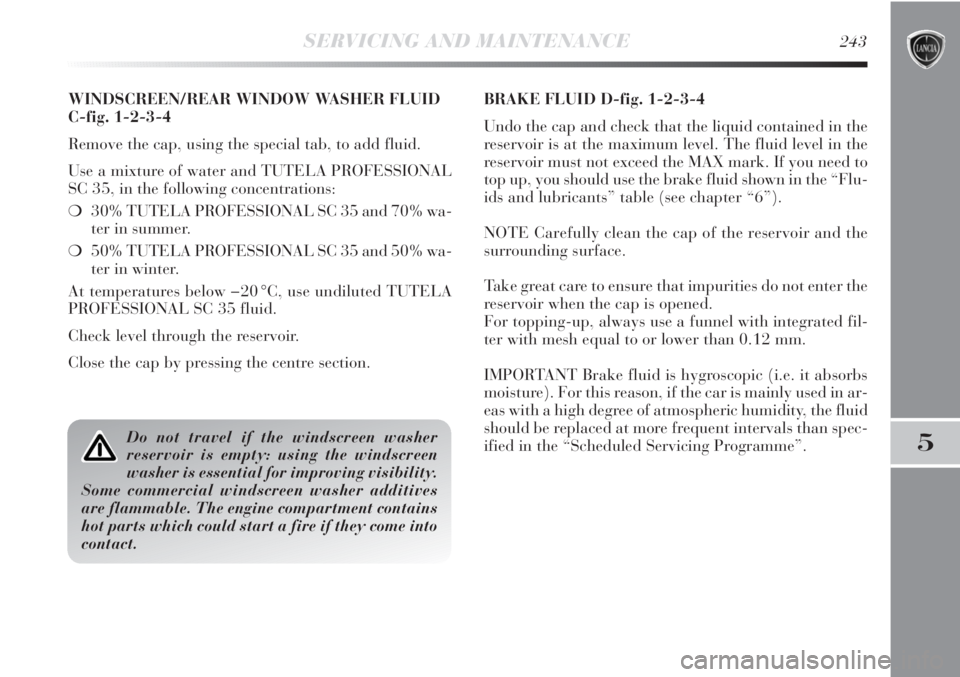
SERVICING AND MAINTENANCE243
5
WINDSCREEN/REAR WINDOW WASHER FLUID
C-fig. 1-2-3-4
Remove the cap, using the special tab, to add fluid.
Use a mixture of water and TUTELA PROFESSIONAL
SC 35, in the following concentrations:
❍30% TUTELA PROFESSIONAL SC 35 and 70% wa-
ter in summer.
❍50% TUTELA PROFESSIONAL SC 35 and 50% wa-
ter in winter.
At temperatures below −20 °C, use undiluted TUTELA
PROFESSIONAL SC 35 fluid.
Check level through the reservoir.
Close the cap by pressing the centre section.
Do not travel if the windscreen washer
reservoir is empty: using the windscreen
washer is essential for improving visibility.
Some commercial windscreen washer additives
are flammable. The engine compartment contains
hot parts which could start a fire if they come into
contact.
BRAKE FLUID D-fig. 1-2-3-4
Undo the cap and check that the liquid contained in the
reservoir is at the maximum level. The fluid level in the
reservoir must not exceed the MAX mark. If you need to
top up, you should use the brake fluid shown in the “Flu-
ids and lubricants” table (see chapter “6”).
NOTE Carefully clean the cap of the reservoir and the
surrounding surface.
Take great care to ensure that impurities do not enter the
reservoir when the cap is opened.
For topping-up, always use a funnel with integrated fil-
ter with mesh equal to or lower than 0.12 mm.
IMPORTANT Brake fluid is hygroscopic (i.e. it absorbs
moisture). For this reason, if the car is mainly used in ar-
eas with a high degree of atmospheric humidity, the fluid
should be replaced at more frequent intervals than spec-
ified in the “Scheduled Servicing Programme”.
Page 246 of 295

244SERVICING AND MAINTENANCE
Prevent brake fluid which is highly corro-
sive from coming into contact with painted
parts. Should this occur, immediately wash
with water.
Brake fluid is poisonous and highly corro-
sive. In the event of accidental contact, im-
mediately wash the affected parts with wa-
ter and neutral soap. Then rinse thoroughly.
If swallowed call a doctor straight away.
The symbol πon the container indicates
a synthetic brake fluid, which is different
from a mineral fluid. Use of mineral type
fluids will damage the special rubber seals of the
braking system beyond repair.
AIR FILTER/POLLEN FILTER
Have the air filter or pollen filter replaced by a Lancia
Dealership.